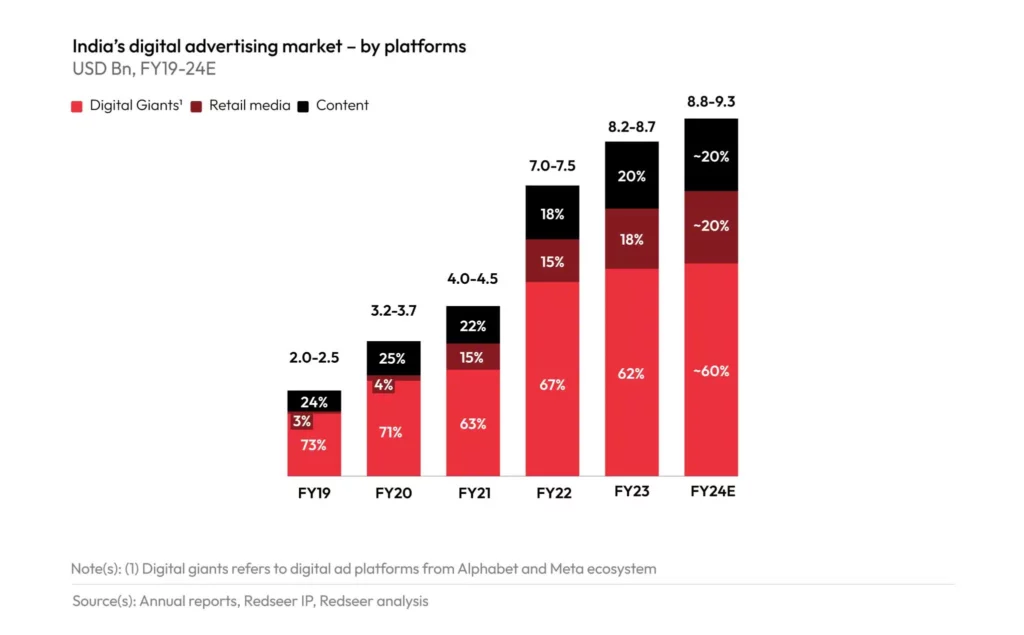In today’s digital age, advertising serves a pivotal role beyond the mere promotion of products and services; it is instrumental in building a company’s brand, fostering trust, and establishing credibility. For numerous digital enterprises, advertising has evolved into a major revenue stream. Despite this, India’s advertising expenditure is estimated to grow only 6% YoY, reaching a total of $16-17 billion in FY24, ending March 31, 2024.
Digital Advertising, in particular, will account for the majority, 55-56%, of India’s total advertising spend in FY24, amounting to $8.8-9.3 billion. However, the anticipated growth in this sector is expected to remain moderate at approximately 6-7% YoY throughout the fiscal year. This growth appears minuscule in comparison to the remarkable surge observed in FY22, where the digital ad market grew an extraordinary 66.7% YoY to $7-7.5 billion. Although there was a moderation to a still commendable 16% growth in FY23, the current fiscal year, FY24, reflects a noticeable lack of confidence among advertisers regarding the anticipated returns.
So, what factors might be contributing to the cautious outlook for advertisers in the current fiscal year?
According to Redseer’s report titled ‘Breaking barriers: Rise of challenger platforms in the digital advertising landscape,’ the anticipated restrained single-digit growth in India’s ad spending for FY24 is primarily attributed to the decline in consumer spending witnessed over the last five to six quarters.
Additionally, the hefty 28% Goods and Services Tax (GST) imposed on India’s online gaming companies has compelled them to implement cost-cutting measures, including reductions in advertising budgets. This uncertainty, coupled with a potential decline in gaming revenue, poses the risk of diminishing the overall advertising expenditure within the sector.
India’s Digital Advertising Market Growth
In India’s dynamic digital advertising market, the share of digital giants, encompassing digital ad platforms within the Alphabet and Meta ecosystems, is projected to reach its lowest point at 60% in FY24. The two other significant players, retail media and content-based platforms, have been eating the market share of digital giants, particularly from the last two fiscal years.
Despite the declining market share, the overall value of digital giants is on an upward trajectory, reflecting the expanding size of the total digital advertising market. In FY24, the ad spending on digital platforms owned by Alphabet and Meta is expected to approach $5-6 billion, illustrating sustained growth, even as their share diminishes to 60%. This contrasts with the figures from FY22 and FY23, where their spending was $5 billion, accompanied by a market share of 67% and 62%, respectively.

Advertisers in India are increasingly reallocating their budgets towards challenger platforms like Retail Media and Content-based platforms, leveraging their niche offerings. Retail Media platforms such as eTailing and Hyperlocal are projected to experience growth in digital advertising market share, increasing from ~15% in FY22 and ~18% in FY23 to ~20% in FY24.
On the other hand, Content-based platforms are anticipated to maintain their consistent ~20% market share in FY24, consistent with FY23, with growth propelled by the popularity of Shortform Video and OTT Video.
The shift in advertisers’ spending strategies is driven by several crucial factors. One key element involves the capability to precisely target users demonstrating strong intent. Moreover, advertisers are keen on broadening their reach to Tier-2 audiences, and capitalize on the extended attention span observed on these platforms, indicating a higher probability of user engagement.
In a Nutshell
Over the next 3-4 years, a favourable shift in advertisers’ perception toward Digital Advertising is anticipated, indicating a notable uptick in advertising expenditures across diverse sectors.
In the Banking, Financial Services, and Insurance (BFSI) sector, there’s a projected increase in advertising spending over the next 3 to 4 years, aiming at accelerating the adoption of advanced financial tools. Simultaneously, the healthcare industry is channelling investments into digital advertising to expedite the promotion of preventive healthcare solutions, aligning with the industry’s evolving focus on proactive health measures.
In the Consumer Packaged Goods (CPG) & Retail sector, key players are strategically leveraging digital advertising to showcase and promote their Direct-to-Consumer (D2C) platforms. This approach reflects a forward-looking strategy to directly engage consumers and enhance the overall retail experience.
In the evolving landscape of India’s digital advertising, what strategies do you believe will be most effective for advertisers to navigate the challenges and capitalize on emerging opportunities in the coming years?

